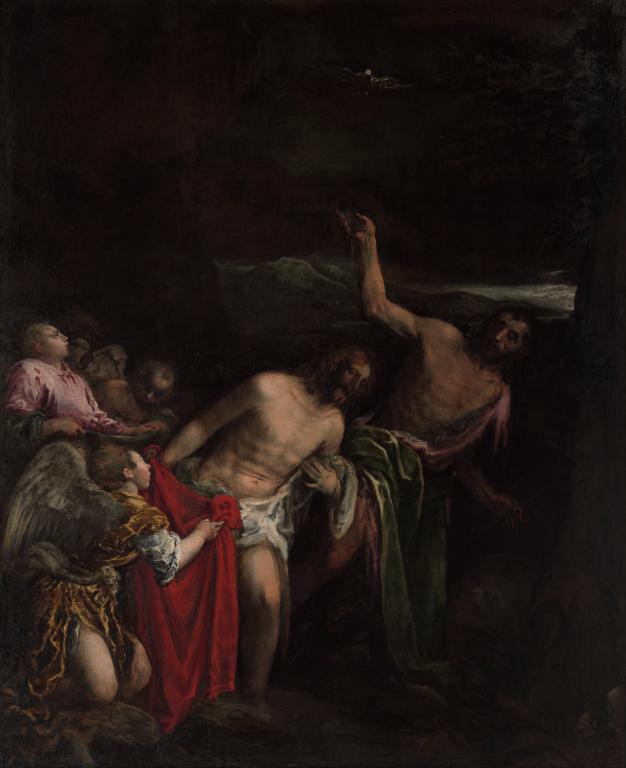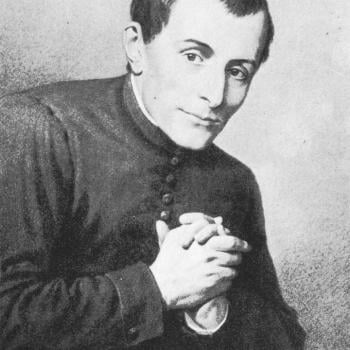I have always been intrigued by the setting of the great Venetian painter Jacopo Bassano’s depiction of Jesus’ baptism. For some reason Bassano painted the baptism at night. I found the move intriguing. It seemed full of poetic potential. I recently ran into some analysis of the work which I found particularly interesting. Here’s Paolo Berdini on the painting:
In Bassano’s Baptism of Christ, the night obscures those
elements—the trees, the water of the Jordan River, and the river
bank—that traditionally provide the beholder with the identifying
circumstances of the event. The truncated tree at the right edge of the
canvas for example, an monographic attribute of the Baptist, is
rendered barely visible by a dash of white paint signalling its profile
against the dark background. By undermining the elements on which
an iconographic reconstruction of the narrative depends, the darkness
detours the beholder’s response towards the illuminated bodies of the
figures. Specifically, the nocturnal illumination emphasizes the perception
that the body of Christ is a suffering body. In Bassano’s image
Christ carries his body with difficulty: he is pale, unsteady on his legs,
out of breath, and dark in the face. His inclining posture represents
quite literally the theological notion of submission to God’s design
that Emile Male has characterized as “the voluntary submission of
Christ” [Tabaissementvolontaire du Christ”].Whereas throughout the Renaissance the figure of Christ at his
baptism had been consistently represented as hieratic, frontal, and
vertical as in Piero’s famous picture, in Bassano’s painting the figure of
Christ has undergone a rotation resulting in a posture that is now
semi-frontal and inclined. If we observe carefully and deconstruct, so
to speak, the new stance, we will discern a dual force at play: a movement
downwards in response to the pressure of light, which irradiates
from the dove above, and a lateral thrust initiated by John the Baptist.
The bowl per infusionem that the Baptist holds between the head of
Christ and the radiant dove establishes the vertical axis of descent to
which the lateral thrust of ascent operates as a counterpoint. The two
forces that determine the instability of the new posture are indicative
of Christ’s dual attitude: the vertical of humility in accepting baptism,
the lateral of submission to God the Father’s design. The lateral thrust
also emphasizes the Baptist’s role in leading Christ into the wilderness,
and represents the fulfillment of his role as the last prophet of the Old
Testament, which Christ’s baptism brings to an end. Entrance into the
wilderness effectively introduces the story of Christ as a story of his
passion. The lateral thrust indicates that Christ has begun his Passion;
figuratively he is about to assume the profile of the carrier of the cross.
In Bassano’s picture it is darkness itself, which the reader of the Gospel
knows to be conclusive, that confirms the allusions to the Passion, and
acts as the sign of the incumbent tragedy of the cross.In summary:
both Christ’s suffering body and the darkness of the image conspire to
alert the beholder that certain dimensions of the Baptism, extra-narratival
and metaphorical, are present and in need of explanation.
That the regeneration alluded to by baptism was the result of
Christ’s sacrifice on the cross, and that immersion in baptismal water
was a sign of participation (or co-action) in Christ’s death was stated
by Paul in one of the most controversial lines of the entire New
Testament: “Do you know that all of us who have been baptized into
Christ were baptized into his death?” (Rom 6:3). This was further
clarified by Origen, who considered baptism a sacramental gift that
should be conceived of, and accepted, as an anticipatory participation
in the sacrifice of the cross. In discussing the Baptism of Christ in the
Jordan River, Ambrose notes that after his death on the cross, Christ
had descended into Hades. His consequent ascent, the resurrection,
was made equivalent to the regeneration that baptism gives the catechumen.
Ambrose speaks of baptism as an act of “imitation” of
Christ’s death, and of the catechumen as being “co-crucified,” and in
full accordance with Paul, conceives of baptism as the sacrament of the
cross.
(From the Article “Jacopo Bassano: A Case for Painting as Visual Exegesis” found in Interpreting Christian Art)













